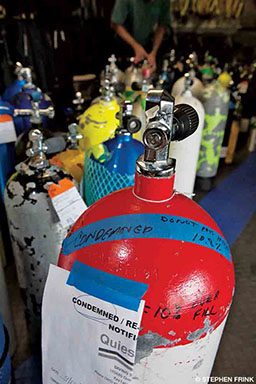In recent months, two 6351-T6 alloy scuba cylinders ruptured, and evidence suggests the cause was sustained load cracking, a metallurgical anomaly. While those present in one incident were fortunate to escape with only minor wounds, the other rupture caused severe injuries. Both cylinder ruptures occurred in countries with little or no cylinder safety regulations.
Let’s examine the facts:
- Both cylinders had recently undergone hydrostatic requalification by untrained testers.
- Neither cylinder had been inspected by a trained visual inspector.
- Neither cylinder was eddy-current tested, as required by U.S. Department of Transportation (USDOT) regulations.
People peripherally involved in the accidents made comments such as, “How long has this been an issue?” and “The cylinders are being used outside of the U.S., so we do not follow U.S. regulations.” One even stated (incorrectly) that “hydrostatic testing is sufficient to determine if a cylinder is still usable.”
For More Information
More information about 6351-T6 alloy cylinders can be found in the PSI-PCI library at www.psicylinders.com.
We have known about sustained load cracking in 6351-T6 alloy cylinders for more than 30 years. Per the cylinder manufacturers, all USDOT cylinders being used anywhere in the world must be retested in accordance with USDOT requalification requirements. In addition to performing hydrostatic retesting and visual inspections to Compressed Gas Association (CGA) and manufacturer’s standards, a formally trained person must also perform an eddy-current test, which uses electromagnetic induction to detect cracks and flaws in materials that conduct electricity.
The common thread in cylinder accidents is little or no training by the retesters, inspectors and fill-station operators. Formal training is required for any person who tests, inspects or fills cylinders — without exception.
Following these accidents, many concerned parties began clamoring for a recall of 6351-T6 alloy cylinders. “We refuse to fill any aluminum cylinder dated 1990 or older,” became a common refrain. Such policies, however, are arbitrary and do not follow any established standards.
The scuba industry faces a conundrum: whether or not to continue using 6351-T6 alloy cylinders. This is a valid question, but the USDOT asserts that any cylinder that passes the required inspections and tests is valid for continued service — regardless of the alloy from which it was made. The only exception to this standard is cylinders with a limited service life.
Continued dissemination of misinformation in the scuba industry has led many operators to refuse to fill any cylinder older than 20 years or 40 years or some number of years they decided was appropriate. Making arbitrary policies, however, can be detrimental to a business’ legal standing. For cylinder owners, such disparate policies can affect their day of diving if the dive shop will not fill their cylinders.

Dive centers want to provide good customer service but sometimes face difficult decisions at the fill station. Should they fill 6351-T6 alloy cylinders? Is it legal to do so? Who tested and inspected the cylinder in question? Is the fill-station operator willing to trust an inspection or requalification done by someone else? Did a reputable, recognized company train the tester and inspector?
Let’s examine several points for practical consideration:Cylinders made of aluminum alloy 6351-T6 are subject to sustained load cracking. If a cylinder is found to be cracked, it must be condemned and removed from service.
- While these cylinders are legal to fill, transport and use per the USDOT, many in the dive industry are not well informed and may refuse to service or fill them. This could lead to refusal of service or the cylinder being condemned in error.
- Many facilities will no longer perform hydrostatic requalification of 6351-T6 alloy cylinders.
- Eddy-current testing is required of 6351-T6 alloy cylinders at the time of hydrostatic testing (per federal regulations) and at the time of visual inspection (by the manufacturers). This generally adds $15-$25 to the cost of the visual inspection and hydrostatic test.
- We know of 31 ruptures of 6351-T6 alloy cylinders out of more than 50 million manufactured. (Note, however, that sustained load cracking occurs over time, and many of these cylinders, which stopped being produced in 1989, might have been retired before a problem occurred.)
- Even if you purchased one of the last of the 6351-T6 alloy cylinders made in 1989, you would have gotten your money’s worth for 28 years of use (roughly $5 per year). Many divers have decided to not retest their 6351-T6 alloy cylinders and have instead retired them, just as they routinely do with other old gear. A 40-year-old regulator might still technically pass its annual service, but its owner might reasonably be less inclined to trust his or her life to it as it ages. For many divers, scrapping old 6351-T6 alloy cylinders is worth the extra peace of mind, even if the improvement in safety is more perceived than measurable.
As you can see, many questions surround 6351-T6 alloy cylinders and their use. By examining the facts and practical considerations, divers can make informed decisions about the continued use of these cylinders.
| © Alert Diver — Q4 2017 |